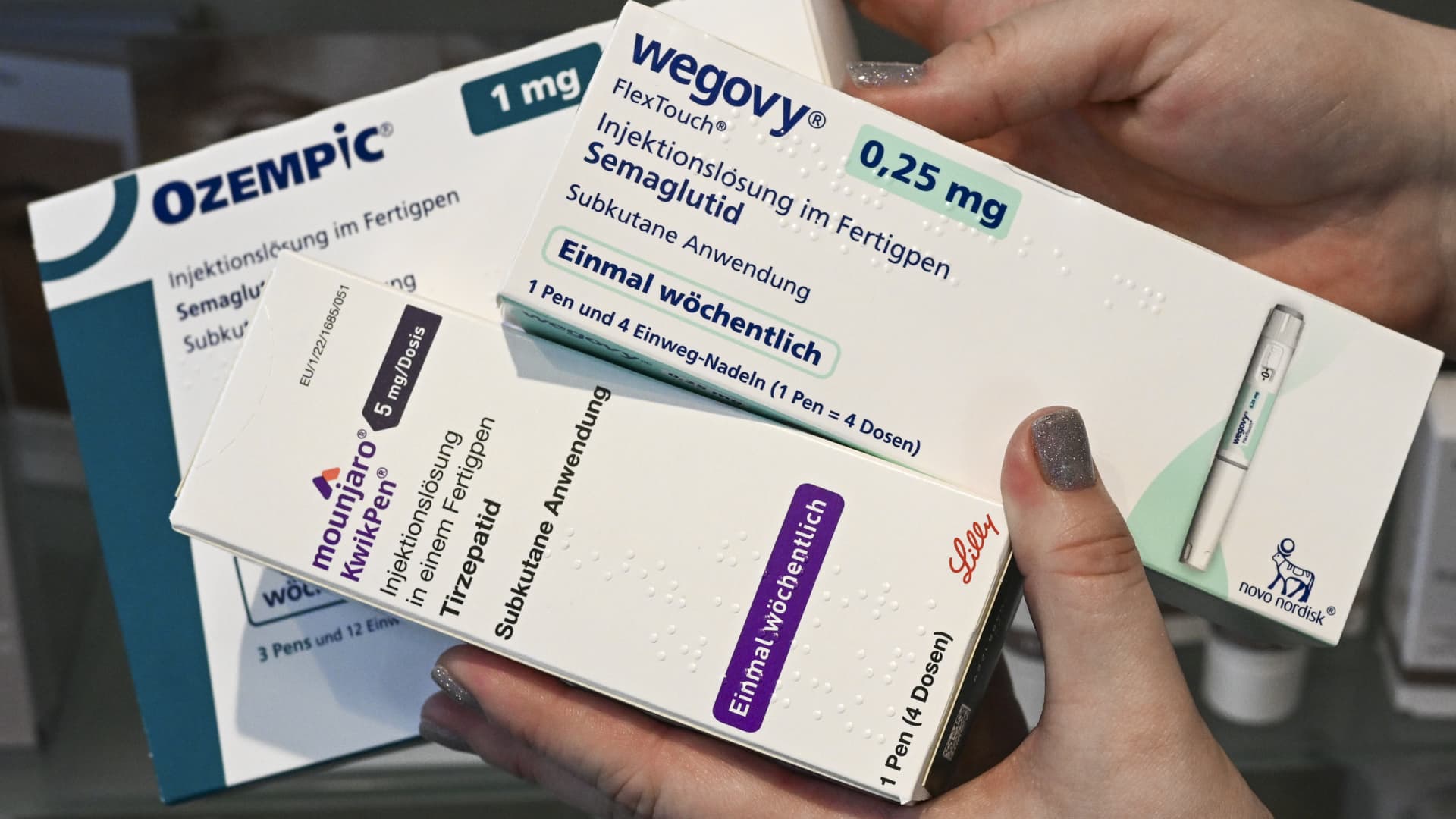Attendees walk through the lobby of the American Society of Clinical Oncology annual meeting in Chicago.
Tim Boyle | Bloomberg | fake images
Do you think a friend or colleague should receive this newsletter? Share this link with them to register.
Good day! I'm back in New York City after spending last weekend in Chicago for the American Society of Clinical Oncology annual meeting.
More than 5,000 research abstracts were presented or published at ASCO. They included data on existing drugs, experimental treatments, artificial intelligence tools and ideas to improve patient care.
Below are some highlights and executive comments from the largest companies I follow:
AstraZeneca win big:
- Tagrisso, the company's second best-selling drug, reduced the risk of disease progression or death by 84% compared to placebo in patients with stage three non-small cell lung cancer caused by mutations in a gene called EGFR, according to new recent studies. results of stage tests. The treatment kept the disease under control for a median of more than three years (or 39 months), while patients who received a placebo had a median progression-free survival of about five months.
- Dave Fredrickson, executive vice president of AstraZeneca's oncology business unit, told me: “We have patients who have almost three years more time before they hear news that their disease has progressed, and half of them haven't even heard that news yet, which means that as we continue to follow this study, there is hope for that we see lasting long-term responses that we could start to call cures.
- David Spigel, scientific director of the Sarah Cannon Research Institute in Nashville, during a news conference last week said the data on Tagrisso “will change practice.”
- AstraZeneca's Imfinzi immunotherapy reduced the risk of death by 27% compared with placebo in patients with limited-stage small cell lung cancer after chemoradiotherapy, according to another late-stage trial. Tagrisso and Imfinzi's test presentations received standing ovations at ASCO.
- Meanwhile, Enhertu, AstraZeneca and Daiichi Sankyo's targeted cancer treatment, reduced the risk of progression or death by 38% compared with chemotherapy in women with a certain type of metastatic breast cancer (patients with low expression of a protein called HER2). -Trial stage had received prior treatment, with at least one line of endocrine therapy.
- TDCowen analyst Steve Scala wrote in a note Thursday that AstraZeneca's “abundance of positive data” at ASCO reinforces the company's $80 billion revenue target by 2030.
Pfizer shows his commitment to cancer:
- Pfizer's Lorbrena drug helped patients live longer without seeing their cancer progress, and most people experienced that benefit for more than five years, according to data from a late-stage trial. The drug also reduces the risk of cancer progressing in patients' brains.
- Chris Boshoff, head of oncology at Pfizer, told me, “In cancer medicine in general, you always want to give the best medicine first. So we believe that this data… will lead to [Lorbrena] becoming a standard” first-line treatment in this specific form of lung cancer.
- A treatment regimen that included Pfizer's targeted cancer treatment, Adcetris, reduced the risk of death by 37% compared with chemotherapy alone in patients with a certain type of lymphoma, according to detailed data from a late-stage trial.
merck, modern Impress with additional facts about cancer vaccines:
- Merck and Moderna's closely followed personalized cancer vaccine in combination with the immunotherapy Keytruda improved survival and showed durable efficacy in a mid-stage study in patients with severe forms of melanoma. The overall survival rate for patients who received the vaccine in combination with Keytruda was 96% after two and a half years. That compares to 90.2% among those who took Keytruda alone.
- Marjorie Green, head of global clinical development for oncology at Merck, He told me, “Looking at three years of updates, what's really exciting to me is seeing the durability of that data.”
- Stéphane Bancel, CEO of Moderna, He told me that progress on a phase three trial of the combination as a treatment for late-stage melanoma is “ahead of our plans” so far.
Bristol-Myers SquibbThe combination treatment shows promise as a first-line treatment for liver cancer:
- Treatment with the company's Opdivo and Yervoy immunotherapies reduced the risk of death compared with standard treatments (either Merck and Eisai's Lenvima or Bayer's Nexavar) in patients with previously untreated advanced liver cancer, according to trial data advanced stage clinicians. Median overall survival was 23.7 months for patients taking the combination compared with 20.6 months with either of the other two drugs.
- Meanwhile, Krazati, Bristol Myers Squibb's lung cancer pill, delayed tumor growth by nearly two months in a late-stage clinical trial. Patients who received the drug lived an average of 5.5 months before their cancer progressed or they died. That compares with a median of 3.8 months for patients who received chemotherapy.
Johnson and Johnson shows a more convenient version of Rybrevant:
- J&J presented new data from a late-stage trial of an injectable version of its lung cancer Rybrevant treatment in combination with a medicine called lazertinib. The study showed that the injectable form is comparable to the approved version in patients with a certain type of non-small cell lung cancer. (The approved form of the drug is administered by intravenous infusion, which can be long and cumbersome for patients.) The company plans to seek approval for the injectable version of Rybrevant in the US.
Eli Lilly presents a renewed oncology line:
- During an event at ASCO, Eli Lilly gave investors a look at early- and late-stage experimental drugs in its oncology pipeline, along with updates on its existing cancer treatments, including Verzenio and Jaypirca. It comes five years after the company announced its acquisition of Loxo Oncology, which kicked off a reorganization of the cancer unit (and involved winding down much of the Eli Lilly portfolio at the time).
- Jake Van Naarden, President of Loxo@Lilly, told me that the windfall from Eli Lilly's popular obesity and diabetes drugs is a rising tide lifting all boats, including the company's oncology business: “The other thing that's certainly not fully appreciated, “Actually, the success that the company is having right now with the incretin portfolio, both for patients and also financially, I think really puts Lilly in a unique position to invest in other things.”
Please feel free to send any tips, suggestions, story ideas or information to Annika at [email protected].
The latest in health technology
Digital physical therapy tools provide clinical benefits, report says
Patients with musculoskeletal conditions who like to stay in their pajamas got some good news Wednesday: They can receive meaningful care from the comfort of their homes, according to a new report from the Peterson Health Technology Institute.
PHTI is a nonprofit organization that conducts independent evaluations of digital health solutions. For its latest report, PHTI reviewed virtual musculoskeletal tools from Hinge Health, Sword Health, Omada Health, DarioHealth, Kaia Health, RecoveryOne, Limber Health, and Vori Health.
Musculoskeletal conditions limit the patient's mobility and can affect the joints, bones and muscles. These disorders are often associated with pain and can be treated with medications, surgery, or a form of rehabilitation such as physical therapy.
PHTI said about one in three people in the U.S. have musculoskeletal conditions and they account for nearly 10% of medical spending in the country, according to a statement Wednesday.
The organization set out to evaluate whether existing virtual tools reduce healthcare costs or provide significant benefits to patients. PHTI found that several of the solutions “offer clinical benefits to patients that are comparable to in-person physical therapy,” according to the release.
To evaluate the clinical and economic performance of the tools, PHTI said it reviewed more than 2,000 scientific articles and received input from experts and patients.
The organization divided the solutions into three categories: physical therapist-led solutions (Sword, Hinge, Omada, Vori and RecoveryOne), app-based exercise therapy with limited participation of physical therapists (Dario, Kaia) and remote therapeutic monitoring solutions, which are designed to complement in-person care (Limber).
PHTI said it found that physical therapist-guided solutions improve patients' functionality and pain in a manner comparable to in-person physical therapy. This means that patients using these solutions from home can expect to see similar results as patients receiving care in person.
App-based exercise therapy helped improve patients' pain and function, but those tools are not effective enough to replace in-person care, according to the report. Additionally, PHTI said that while evidence on remote therapeutic monitoring tools was limited, they provide better clinical outcomes in combination with in-person physical therapy compared to in-person therapy alone.
Physical therapist-guided solutions also reduce net spending, according to the report. PHTI said remote therapeutic monitoring tools increase net spending and no pricing data was available for app-based exercise therapy.
PHTI said that based on its review, virtual musculoskeletal tools successfully provide “significant improvements in pain and function compared to usual care.” Virtual tools can also help increase access to care, particularly for patients who are older, live in rural areas or cannot easily travel to an in-person clinic, PHTI said.
You can read the full PHTI report here.
Please feel free to send any tips, suggestions, story ideas, or information to Ashley at [email protected].












